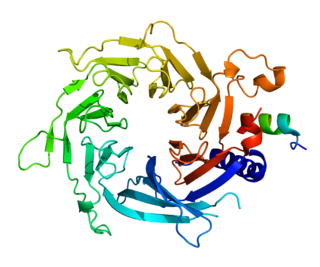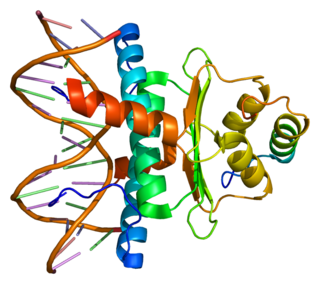Paired amphipathic helix protein Sin3a is a protein that in humans is encoded by the SIN3A gene. [5] [6]
Paired amphipathic helix protein Sin3a is a protein that in humans is encoded by the SIN3A gene. [5] [6]
The protein encoded by this gene is a transcriptional regulatory protein. It contains paired amphipathic helix (PAH) domains, which are important for protein-protein interactions and may mediate repression by the Mad-Max complex. [7]
SIN3A has been shown to interact with:
The mSin3 interaction domain (SID) is an interaction domain which is present on several transcriptional repressor proteins including TGFβ and Mad. It interacts with the paired amphipathic alpha-helix 2 (PAH2) domain of mSin3, a transcriptional repressor domain that is attached to transcription repressor proteins such as the mSin3A corepressor.
In molecular biology and genetics, transcription coregulators are proteins that interact with transcription factors to either activate or repress the transcription of specific genes. Transcription coregulators that activate gene transcription are referred to as coactivators while those that repress are known as corepressors. The mechanism of action of transcription coregulators is to modify chromatin structure and thereby make the associated DNA more or less accessible to transcription. In humans several dozen to several hundred coregulators are known, depending on the level of confidence with which the characterisation of a protein as a coregulator can be made. One class of transcription coregulators modifies chromatin structure through covalent modification of histones. A second ATP dependent class modifies the conformation of chromatin.

Histone deacetylase 1 (HDAC1) is an enzyme that in humans is encoded by the HDAC1 gene.

The nuclear receptor co-repressor 1 also known as thyroid-hormone- and retinoic-acid-receptor-associated co-repressor 1 (TRAC-1) is a protein that in humans is encoded by the NCOR1 gene.

The nuclear receptor co-repressor 2 (NCOR2) is a transcriptional coregulatory protein that contains several nuclear receptor-interacting domains. In addition, NCOR2 appears to recruit histone deacetylases to DNA promoter regions. Hence NCOR2 assists nuclear receptors in the down regulation of target gene expression. NCOR2 is also referred to as a silencing mediator for retinoid or thyroid-hormone receptors (SMRT) or T3 receptor-associating cofactor 1 (TRAC-1).

In genetics and molecular biology, a corepressor is a molecule that represses the expression of genes. In prokaryotes, corepressors are small molecules whereas in eukaryotes, corepressors are proteins. A corepressor does not directly bind to DNA, but instead indirectly regulates gene expression by binding to repressors.

Histone deacetylase 2 (HDAC2) is an enzyme that in humans is encoded by the HDAC2 gene. It belongs to the histone deacetylase class of enzymes responsible for the removal of acetyl groups from lysine residues at the N-terminal region of the core histones. As such, it plays an important role in gene expression by facilitating the formation of transcription repressor complexes and for this reason is often considered an important target for cancer therapy.

Histone deacetylase 3 is an enzyme encoded by the HDAC3 gene in both humans and mice.

Histone-binding protein RBBP4 is a protein that in humans is encoded by the RBBP4 gene.

Histone deacetylase 4, also known as HDAC4, is a protein that in humans is encoded by the HDAC4 gene.

Histone-binding protein RBBP7 is a protein that in humans is encoded by the RBBP7 gene.

Histone deacetylase 5 is an enzyme that in humans is encoded by the HDAC5 gene.

Histone deacetylase 9 is an enzyme that in humans is encoded by the HDAC9 gene.

Homeobox protein TGIF1 is a protein that, in humans, is encoded by the TGIF1 gene. Alternative splicing has been observed at this locus and eight variants, encoding four distinct isoforms, are described.

Sin3A-associated protein, 30kDa, also known as SAP30, is a protein which in humans is encoded by the SAP30 gene.

Paired amphipathic helix protein Sin3b is a protein that in humans is encoded by the SIN3B gene.

Calcineurin-binding protein cabin-1 is a protein that in humans is encoded by the CABIN1 gene.

MAD protein is a protein that in humans is encoded by the MXD1 gene.

Histone deacetylase complex subunit SAP18 is an enzyme that in humans is encoded by the SAP18 gene.

Sin3 histone deacetylase corepressor complex component SDS3 is an enzyme that in humans is encoded by the SUDS3 gene.
This article incorporates text from the United States National Library of Medicine, which is in the public domain.